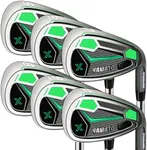Buying Guide for the Best Callaway Iron Sets
Choosing the right Callaway iron set can significantly improve your golf game. The right set will complement your playing style, skill level, and physical attributes. When selecting an iron set, it's important to consider various specifications that can affect your performance on the course. Understanding these key specs will help you make an informed decision and find the best fit for your needs.Clubhead DesignThe clubhead design of an iron set can greatly influence your game. There are generally three types: cavity back, muscle back, and game improvement. Cavity back irons are more forgiving and suitable for beginners or high-handicap players. Muscle back irons, also known as blades, offer more control and are preferred by advanced players. Game improvement irons are designed to help with distance and accuracy, making them ideal for mid-handicap players. Choose a clubhead design that matches your skill level and playing style.
Shaft MaterialThe shaft material of your irons can affect the feel and performance of your shots. The two main types are steel and graphite. Steel shafts are heavier and provide more control and feedback, making them suitable for players with faster swing speeds. Graphite shafts are lighter and can help increase swing speed, making them ideal for players with slower swing speeds or those looking for more distance. Consider your swing speed and desired feel when choosing the shaft material.
Shaft FlexShaft flex refers to the amount of bend in the shaft during your swing. Common flex options include extra stiff (X), stiff (S), regular (R), senior (A), and ladies (L). Extra stiff and stiff flexes are suitable for players with faster swing speeds, providing more control and accuracy. Regular flex is a good all-around option for average swing speeds. Senior and ladies flexes are designed for slower swing speeds, offering more distance and ease of use. Match the shaft flex to your swing speed for optimal performance.
Set CompositionThe composition of an iron set refers to the specific irons included, such as 3-iron through pitching wedge (PW). Some sets may also include additional wedges or hybrids. Beginners and high-handicap players may benefit from sets with more hybrids, as they are easier to hit than long irons. Advanced players might prefer a traditional set with more irons for greater control. Consider your skill level and the types of shots you need to make when choosing the set composition.
LoftLoft is the angle of the clubface that controls the trajectory and distance of your shots. Higher lofted clubs, like wedges, produce higher, shorter shots, while lower lofted clubs, like long irons, produce lower, longer shots. Understanding the loft of each iron in the set can help you manage your distances and shot selection on the course. Choose a set with lofts that complement your playing style and help you cover the necessary distances.
Lie AngleThe lie angle is the angle between the club's shaft and the ground when the club is at address. A proper lie angle ensures that the clubhead makes solid contact with the ball, promoting accuracy and consistency. If the lie angle is too upright or too flat, it can cause the ball to veer off course. Getting fitted for the correct lie angle based on your height, arm length, and swing style can greatly improve your performance.
ForgivenessForgiveness refers to the club's ability to minimize the effects of off-center hits. Irons with higher forgiveness have larger sweet spots and are designed to help players achieve better results even on mishits. Beginners and high-handicap players should look for irons with high forgiveness to improve their consistency and confidence. More advanced players may prioritize other factors, such as control and feel, over forgiveness.
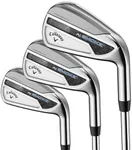
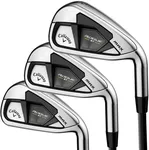
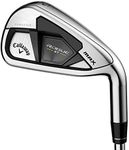

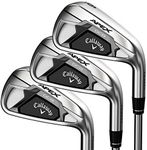

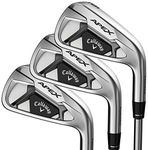
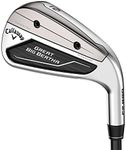



![PGF Gold TP Forged Iron Set 4-PW[ 7 Clubs] [Length: Standard] [Flex: Reg][RH]](https://images-proxy.bestreviews.guide/tOF7tV2auFDswj09TaZncsHYk_M=/0x150/https://m.media-amazon.com/images/I/31avKkHWccL._AC_CX679_.jpg)
